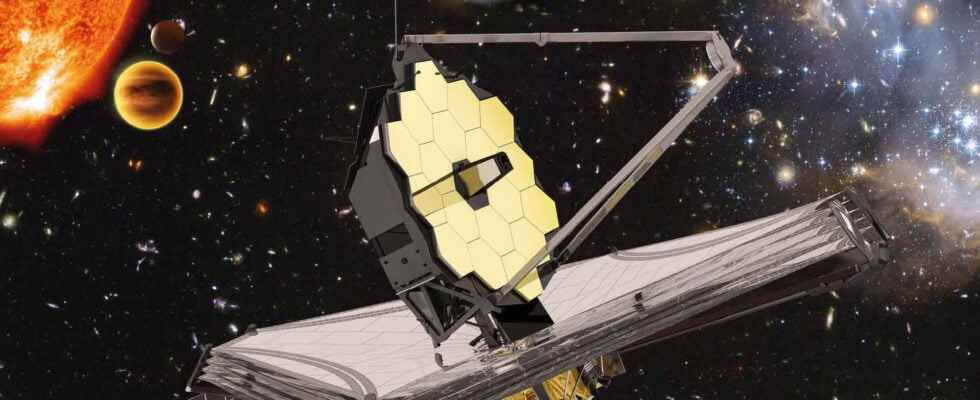The James Webb Space Telescope team has fully deployed the spacecraft’s sunshade in space, a key step in their preparation for science operations. Next step: the secondary mirror.
The sun visor of the James Webb Space Telescope was successfully unfolded and stretched after an eight-day multi-stage operation. About the size of a tennis court and made of five layers, the sunshade is intended to protect the telescope of the light and some heat issued by the Sun, the Earth and also the Moon. It had to be bent to fit the pitcher’s cap Ariane 5. Its rollout began on December 28, 2021, three days after launch.
“Unfolding Webb’s sun visor in space is an incredible and crucial step to the success of the mission, said Gregory L. Robinson, program director for Webb at the headquarters of the Nasa. Thousands of parts had to be worked with precision for this engineering marvel to unfold completely. The team accomplished a daring feat with the complexity of this deployment, making it one of the most daring endeavors for Webb ” he greeted.
The next steps
Unwinding and tensioning the sunshade involved 139 of Webb’s 178 trigger mechanisms, 70 hinge assemblies, 8 deployment motors, approximately 400 pulleys, and 90 individual cables totaling almost half a mile in length.
The team suspended deployment operations for a day so that they could work on optimizing the power systems and voltage motors and ensure that the JWST was in perfect condition before moving on to the crucial stage of tensioning the sunshade.
The largest and most complex space telescope ever to launch into space still has five and a half months of configuration before delivering its first images and starting scientific research. In the coming days, it is planned to unfold the tripod of the mirror secondary then the wings of the primary mirror. The alignment of the optics, start-up and calibration of the instruments will follow.
Revolutionary telescope technology will explore every phase of cosmic history, from the very interior of our Solar System to the most distant galaxies within the early universe. Webb will offer unexpected discoveries and help humanity understand the origins of the Universe and our place in it.
Three days after its launch, where is the James Webb Space Telescope?
Article by Nathalie Mayer published on December 28, 2021
Its launch had been repeatedly postponed. The operation finally went off without a hitch on Saturday, December 25, 2021. Today, a new crucial step awaits the James Webb space telescope: the deployment of its heat shield.
Three days after being launched from the Kourou base (Guyana), the James Webb Space Telescope (JWST) continues on its way towards its orbit operational L2, 1.5 million kilometers from our Earth. He deployed his solar panel and thus started to produce energy. Then he carried out a first operation to correct his trajectory. He then took out the antenna that will allow him to transfer the observation data to Earth. Then underwent a second course correction operation. And a few hours ago he passed theorbit of the moon.
A new critical phase for the James Webb Space Telescope is due today. The beginning of the deployment of its heat shield. A kind of sun visor intended to protect it from the radiation emitted by our Star.
Protecting the James Webb Space Telescope from the Sun
The operation is crucial for astronomers. The objective of the James Webb Space Telescope is indeed to observe the Universe back under the sun. In the cold. At around -266 ° C. The temperature necessary for quality observations in theinfrared.
For now, the JWST’s heat shield is still folded up like an accordion. But the five layers of membranes that compose it will soon unfold. For a full deployment, it will still take several days. The shield measuring no less than the size of a tennis court. Only then – within a week – can the deployment of the telescope’s mirror begin.
Remember that the James Webb space telescope does not arrive safely for a month. And it will then be necessary to wait several more weeks before it is fully operational. For the first observations, see you next June.
Interested in what you just read?
.
fs3
